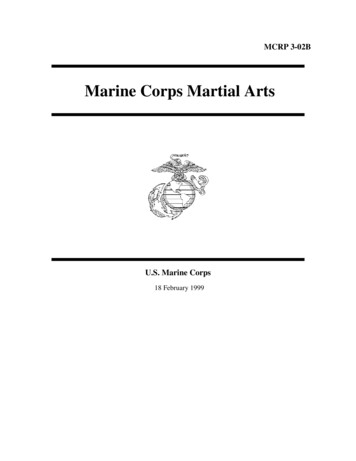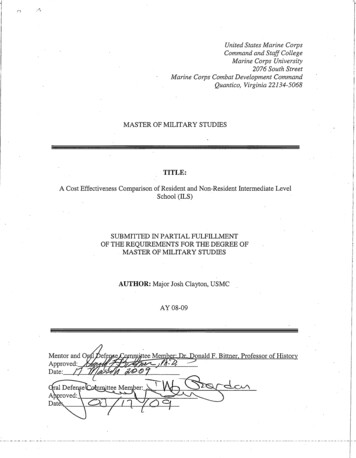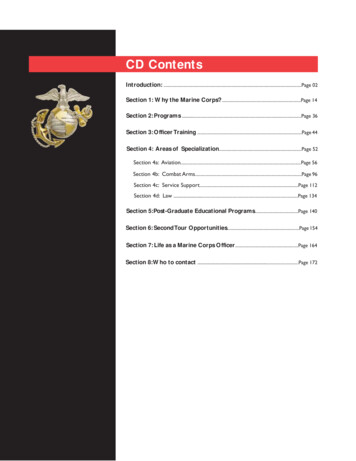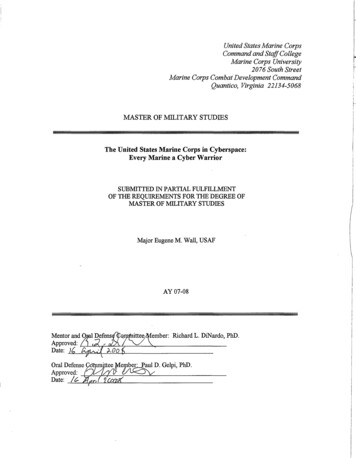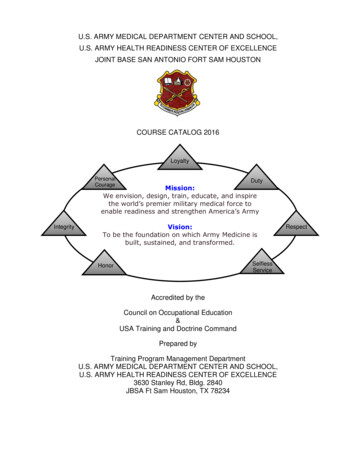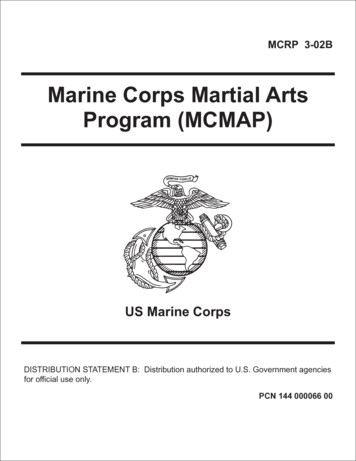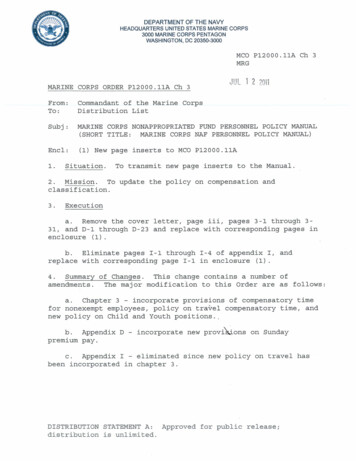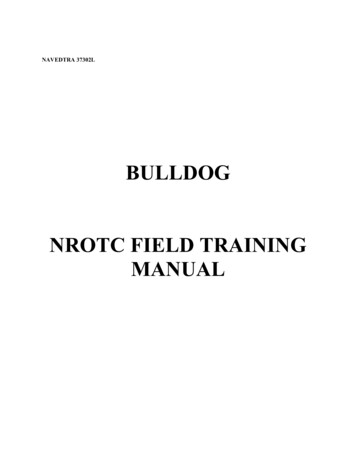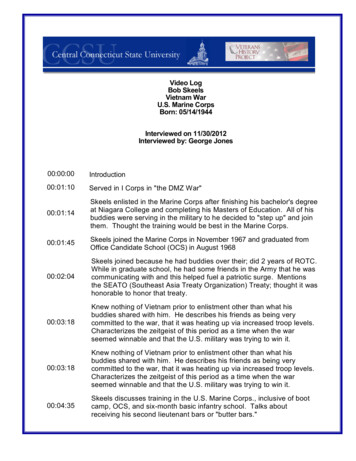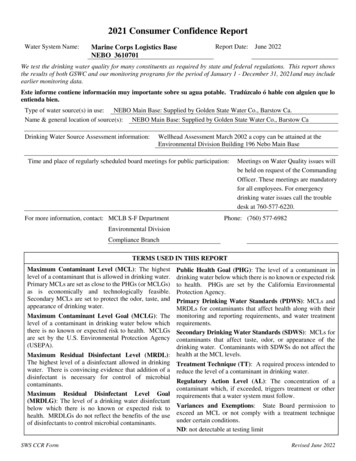
Transcription
2021 Consumer Confidence ReportWater System Name:Marine Corps Logistics BaseNEBO 3610701Report Date:June 2022We test the drinking water quality for many constituents as required by state and federal regulations. This report showsthe results of both GSWC and our monitoring programs for the period of January 1 - December 31, 2021and may includeearlier monitoring data.Este informe contiene información muy importante sobre su agua potable. Tradúzcalo ó hable con alguien que loentienda bien.Type of water source(s) in use: NEBO Main Base: Supplied by Golden State Water Co., Barstow Ca.Name & general location of source(s): NEBO Main Base: Supplied by Golden State Water Co., Barstow CaDrinking Water Source Assessment information:Wellhead Assessment March 2002 a copy can be attained at theEnvironmental Division Building 196 Nebo Main BaseTime and place of regularly scheduled board meetings for public participation:For more information, contact: MCLB S-F DepartmentMeetings on Water Quality issues willbe held on request of the CommandingOfficer. These meetings are mandatoryfor all employees. For emergencydrinking water issues call the troubledesk at 760-577-6220.Phone: (760) 577-6982Environmental DivisionCompliance BranchTERMS USED IN THIS REPORTMaximum Contaminant Level (MCL): The highestlevel of a contaminant that is allowed in drinking water.Primary MCLs are set as close to the PHGs (or MCLGs)as is economically and technologically feasible.Secondary MCLs are set to protect the odor, taste, andappearance of drinking water.Maximum Contaminant Level Goal (MCLG): Thelevel of a contaminant in drinking water below whichthere is no known or expected risk to health. MCLGsare set by the U.S. Environmental Protection Agency(USEPA).Maximum Residual Disinfectant Level (MRDL):The highest level of a disinfectant allowed in drinkingwater. There is convincing evidence that addition of adisinfectant is necessary for control of microbialcontaminants.Maximum Residual Disinfectant Level Goal(MRDLG): The level of a drinking water disinfectantbelow which there is no known or expected risk tohealth. MRDLGs do not reflect the benefits of the useof disinfectants to control microbial contaminants.SWS CCR FormPublic Health Goal (PHG): The level of a contaminant indrinking water below which there is no known or expected riskto health. PHGs are set by the California EnvironmentalProtection Agency.Primary Drinking Water Standards (PDWS): MCLs andMRDLs for contaminants that affect health along with theirmonitoring and reporting requirements, and water treatmentrequirements.Secondary Drinking Water Standards (SDWS): MCLs forcontaminants that affect taste, odor, or appearance of thedrinking water. Contaminants with SDWSs do not affect thehealth at the MCL levels.Treatment Technique (TT): A required process intended toreduce the level of a contaminant in drinking water.Regulatory Action Level (AL): The concentration of acontaminant which, if exceeded, triggers treatment or otherrequirements that a water system must follow.Variances and Exemptions: State Board permission toexceed an MCL or not comply with a treatment techniqueunder certain conditions.ND: not detectable at testing limitRevised June 2022
Consumer Confidence ReportPage 2 of 5MFL: million fibers per literppm: parts per million or milligrams per liter (mg/L)ppb: parts per billion or micrograms per liter (µg/L)ppt: parts per trillion or nanograms per liter (ng/L)ppq: parts per quadrillion or picogram per liter (pg/L)pCi/L: picocuries per liter (a measure of radiation)uS/cm: one millionth of a Siemen per centimeter (a measureof conductivity)The sources of drinking water (both tap water and bottled water) include rivers, lakes, streams, ponds, reservoirs, springs,and wells. As water travels over the surface of the land or through the ground, it dissolves naturally-occurring mineralsand, in some cases, radioactive material, and can pick up substances resulting from the presence of animals or from humanactivity.Contaminants that may be present in source water include: Microbial contaminants, such as viruses and bacteria, that may come from sewage treatment plants, septic systems,agricultural livestock operations, and wildlife.Inorganic contaminants, such as salts and metals, that can be naturally-occurring or result from urban storm waterrunoff, industrial or domestic wastewater discharges, oil and gas production, mining, or farming.Pesticides and herbicides, that may come from a variety of sources such as agriculture, urban storm water runoff, andresidential uses.Organic chemical contaminants, including synthetic and volatile organic chemicals, that are by-products of industrialprocesses and petroleum production, and can also come from gas stations, urban storm water runoff, agriculturalapplication, and septic systems.Radioactive contaminants, that can be naturally-occurring or be the result of oil and gas production and miningactivities.In order to ensure that tap water is safe to drink, the USEPA and the State Water Resources Control Board (State Board)prescribe regulations that limit the amount of certain contaminants in water provided by public water systems. State Boardregulations also establish limits for contaminants in bottled water that provide the same protection for public health.Tables 1, 2, 3, 4, 5, 7, and 8 list all of the drinking water contaminants that were detected during the most recentsampling for the constituent. The presence of these contaminants in the water does not necessarily indicate that the waterposes a health risk. The State Board allows us to monitor for certain contaminants less than once per year because theconcentrations of these contaminants do not change frequently. Some of the data, though representative of the water quality,are more than one year old.TABLE 1 – SAMPLING RESULTS SHOWING THE DETECTION OF COLIFORM BACTERIAHighest No.of(complete if bacteria detected) DetectionsTotal Coliform Bacteria(In a mo.)1Fecal Coliform or E. coli (In the year)0MicrobiologicalContaminantsNo. of months inviolation00MCLMCLGMore than 1 sample in amonth with a detectionA routine sample and arepeat sample detecttotal coliform and eithersample also detects fecalcoliform or E. coli00Typical Source of BacteriaNaturally present in theenvironmentHuman and animal fecal wasteTABLE 2 – SAMPLING RESULTS SHOWING THE DETECTION OF LEAD AND COPPERLead and Copper(complete if lead or copperdetected in the last sample set)Lead (ppb)SWS CCR FormSampleDate202190thNo. ofpercentilesampleslevelcollecteddetected10NDNo. sitesexceedingALALPHG0150.2Typical Source of ContaminantInternal corrosion of householdwater plumbing systems;discharges from industrialRevised June 2022
Consumer Confidence ReportPage 3 of 5manufacturers; erosion of naturaldepositsCopper (ppm)2021100.34001.30.3Internal corrosion of householdplumbing systems; erosion ofnatural deposits; leaching fromwood preservativesThe 2017 amendment to domestic water supply permits require K-12 schools to be tested for lead. MCLB Nebo Annex does notcontain K-12 schools, therefore does not require this testing.In 2021 Lead and Copper sampling was performed in October, which is outside of the required monitoring window between June and September.A monitoring violation resulted; however NO EXCEEDANCES were observed. Table 7 below highlights the violation details.TABLE 3 – SAMPLING RESULTS FOR SODIUM AND HARDNESSChemical or Constituent(and reporting units)Sodium (ppm) **SampleDate2020LevelDetected69Range ofDetections64 - 76MCLnonePHG(MCLG)noneTypical Source of ContaminantSalt present in the water and isgenerally naturally occurringHardness (ppm) **2020240170 - 290nonenoneSum of polyvalent cations presentin the water, generally magnesiumand calcium, and are usuallynaturally occurring*Any violation of an MCL or AL is asterisked. Additional information regarding the violation is provided later in this report.** Analytical results from GSWCTABLE 4 – DETECTION OF CONTAMINANTS WITH A PRIMARY DRINKING WATER STANDARDChemical or Constituent(and reporting units)MCLPHG(MCLG)SampleDateLevelDetectedRange ofDetections[MRDL][MRDLG]Gross Alpha ParticleActivity (pCi/L) **20213.4ND – 5.515(0)Erosion of Natural DepositsUranium (pCi/L) **20183.01.9 - 5.1200.43Erosion of Natural DepositsArsenic (ppb) **20202.82.1 – 3.4100.004Barium (ppm) **2020NDND - 0.1411Chlorine [CL2] (ppm)20211.321.1 – 1.52[MRDL 4](as Cl2)[MRDL 4](as Cl2)Erosion of Natural Deposits; runofffrom orchards; glass and electronicsproduction wastes.Discharge of oil drilling waste andfrom metal refineries; Erosion ofNatural DepositsDrinking water disinfectant addedfor treatmentFluoride (ppm) **20200.410.33 - 0.552.01Haloacetic Acid (HAA5)(ppb)20215.954.4 – 7.560n/aNickel (ppb) **2020NDND - 1010012Nitrate as Nitrogen(ppm)**20213.62.3 – 7.610(as N)10(as N)Total Trihalomethanes(TTHMs) (ppb)20219.151.3 – 1780n/aTypical Source of ContaminantErosion of Natural Deposits; wateradditive which promotes strongteeth; discharge from fertilizer andaluminum factoriesBy-product of drinking waterdisinfectionErosion of natural deposits;discharge from metal factoriesRunoff and leaching from fertilizeruse; leaching from septic tanks andsewage; erosion of natural depositsBy-product of drinking waterdisinfection*Any violation of an MCL or AL is asterisked. Additional information regarding the violation is provided later in this report.** Analytical results from GSWCTABLE 5 – DETECTION OF CONTAMINANTS WITH A SECONDARY DRINKING WATER STANDARDSWS CCR FormRevised June 2022
Consumer Confidence ReportChemical or Constituent(and reporting units)Page 4 of 5SampleDateLevelDetectedRange ofDetectionsMCLPHG(MCLG)Alkalinity (ppm) **2020140120 - 170n/an/aCalcium (ppm) **Chloride (ppm) **20202020728554 - 9171 - 100n/a500n/an/aMagnesium (ppm) **2020139.5-16n/an/aIron2020NDND-100300n/aOdor – Threshold (units)2020NDND - 1.73n/apH (pH units)20217.67.4 - 7.9n/an/aPotassium (ppm) **20202.92.4 - 3.3n/an/aSpecific Conductance(uS/cm) **2020780660 - 8801600n/aSubstances that form ions when inwater; seawater influenceSulfate (ppm) **202012097 - 170500n/aRunoff/leaching from naturaldeposits; industrial wastesTotal Dissolved Solids(TDS) (ppm) **2020510430 - 5701000n/aRunoff/leaching from naturaldepositsTurbidity (units)20210.550.10 – 1.05n/aSoil runoffTypical Source of ContaminantRunoff/leaching from naturaldeposits; seawater influenceLeaching from natural deposits;industrial wastesNaturally-occurring organicmaterials*Any violation of an MCL or AL is asterisked. Additional information regarding the violation is provided later in this report.** Analytical results from GSWCTABLE 6 – DETECTION OF UNREGULATED CONTAMINANTSSampleDateLevelDetectedRange ofDetectionsNotification LevelManganese20190.50ND-2.3n/aPFOS (ppt)20212.282.23 – 2.3070See statements belowPFOA (ppt)20211.391.19 - 1.5370See statements belowChemical or Constituent(and reporting units)Typical Source of ContaminantWhat are per- and polyfluoroalkyl substances and where do they come from?Per- and Polyfluoroalkyl substances (PFAS) refers to a large class of substances, which includes perfluorooctane sulfonate(PFOS) and perfluorooctanic acid (PFOA). DoD’s use of PFAS started in the 1970s, with the introduction of aqueous filmforming foam (AFFF) for aircraft fuel fire-fighting purposes. AFFF is mission critical because it quickly extinguishespetroleum-based fires, thus minimizing loss of life. DoD is one of many users of AFFF, with other major users includingcommercial airports, the oil and gas industry, and local fire departments. PFAS are also present in many industrial andconsumer products because they increase a product’s resistance to heat, stains, water and grease. As such, they are notuniquely attributable to DoD activities.Is there a regulation for PFAS in drinking water? 1There is currently no federal drinking water standard or regulation for PFAS. In May 2016, the EPA established drinkingwater health advisory levels at 70 parts per trillion (ppt) for perfluorooctanesulfonic acid (PFOS) and perfluorooctanoicacid (PFOA), individually or combined. Both PFOS and PFOA are types of PFAS.While not a requirement under the Safe Drinking Water Act, DoD proactively issued a policy to monitor drinking waterfor 18 PFAS at all DoD-owned and operated water systems at a minimum of every three years.SWS CCR FormRevised June 2022
Consumer Confidence ReportPage 5 of 5The EPA recommends if water sampling results confirm that drinking water contains PFOA and PFOS at individual orcombined concentrations greater than 70 parts per trillion, water systems should quickly undertake additional sampling toassess the level, scope, and localized source of contamination to inform next steps.Has MCLBB Nebo tested its water for PFAS?Yes. In May, August and November 2021 samples were collected from the Nebo Drinking Water Facility building S-48.We are informing you that six of the 18 PFAS compounds covered by the sampling method were detected at or above themethod reporting limit (MRL). PFOS and PFOA, the two compounds included in the EPA lifetime HA, were below theEPA lifetime HA level. The results are provided in Table 6. Consistent with the EPA lifetime HA, since PFOS and PFOAare below the EPA HA levels, no adverse health impacts are expected over a lifetime of drinking this water. In accordancewith DoD policy, MCLBB Nebo will collect quarterly samples for the 18 PFAS for one year and then every two yearsthereafter as long as the results are below the MRL.Additional General Information on Drinking WaterDrinking water, including bottled water, may reasonably be expected to contain at least small amounts of somecontaminants. The presence of contaminants does not necessarily indicate that the water poses a health risk. Moreinformation about contaminants and potential health effects can be obtained by calling the USEPA’s Safe Drinking WaterHotline (1-800-426-4791).Some people may be more vulnerable to contaminants in drinking water than the general population. Immuno-compromisedpersons such as persons with cancer undergoing chemotherapy, persons who have undergone organ transplants, people withHIV/AIDS or other immune system disorders, some elderly, and infants can be particularly at risk from infections. Thesepeople should seek advice about drinking water from their health care providers. USEPA/Centers for Disease Control (CDC)guidelines on appropriate means to lessen the risk of infection by Cryptosporidium and other microbial contaminants areavailable from the Safe Drinking Water Hotline (1-800-426-4791).Nitrate in drinking water at levels above 10 mg/L is a health risk for infants of less than six months of age. Such nitratelevels in drinking water can interfere with the capacity of the infant’s blood to carry oxygen, resulting in a serious illness;symptoms include shortness of breath and blueness of the skin. Nitrate levels above 10 mg/L may also affect the ability ofthe blood to carry oxygen in other individuals, such as pregnant women and those with certain specific enzyme deficiencies.If you are caring for an infant, or you are pregnant, you should ask advice from your health care providerLead-Specific Language for Community Water Systems: If present, elevated levels of lead can cause serious healthproblems, especially for pregnant women and young children. Lead in drinking water is primarily from materials andcomponents associated with service lines and home plumbing. Golden State Water Company is responsible for providinghigh quality drinking water, but cannot control the variety of materials used in plumbing components. When your waterhas been sitting for several hours, you can minimize the potential for lead exposure by flushing your tap for 30 seconds to2 minutes before using water for drinking or cooking. If you are concerned about lead in your water, you may wish to haveyour water tested. Information on lead in drinking water, testing methods, and steps you can take to minimize exposure isavailable from the Safe Drinking Water Hotline or at http://www.epa.gov/safewater/lead.Summary Information for Violation of the Monitoring and Reporting RequirementTABLE 7 – VIOLATION OF MONITORING REPORTING REQUIREMENTViolationCitation No. 05-13-21C-029Citation for NoncomplianceCalifornia Code ofRegulations, Title 22,Section 64675 and 64675.5Lead and CopperMonitoring Violation 2021SWS CCR FormExplanationMonitoring notperformed duringrequiredtimeframe ofJune-September2021Duration 1 monthActions Taken to Correct ViolationInterim monitoring was performed in October2021. Interim results shown in Table 2demonstrate no sites exceeded the AL inOctober 2021; however the sampling wasperformed outside of the required samplingwindow.Health Effects LanguageSee “Lead-SpecificLanguage” in the “AdditionalGeneral Information onDrinking Water” section.Lead and Copper Monitoring will be performedin 2022 within the required sampling months ofRevised June 2022
Consumer Confidence ReportPage 6 of 5June-September. Results will be provided inthe 2022 Consumer Confidence Report.SWS CCR FormRevised June 2022
Type of water source(s) in use: NEBO Main Base: Supplied by Golden State Water Co., Barstow Ca. Name & general location of source(s): NEBO Main Base: Supplied by Golden State Water Co., Barstow Ca Drinking Water Source Assessment information: Wellhead Assessment March 2002 a copy can be attained at the


